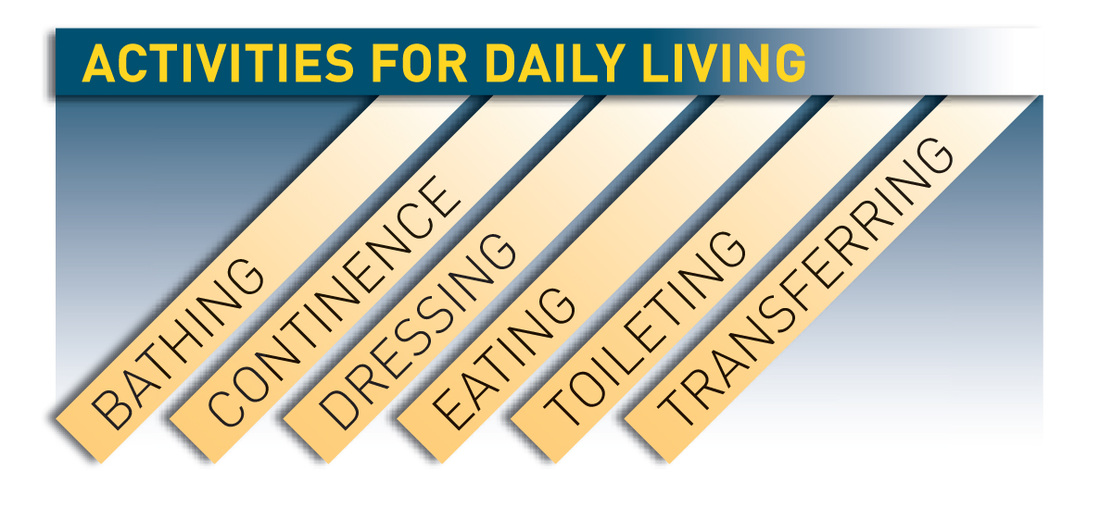LONG TERM CARE INSURANCE: Anymore with even a passing experience with Alzheimer's, stroke, Parkinson's or elder frailty can appreciate the severity and financial devastation of these all-too-common life events and the inevitable care required. This is why long term care insurance protection can be important. A long term care policy helps pay for care you need when you can no longer care for yourself. It may protect your family's financial future and your own investments and savings.
BENEFIT TRIGGERS: Are qualifying events to become eligible to receive benefits under your Long Term Care Insurance policy. In a tax qualified policy this will be the requirements to need assistance for at least 90 days with 2 of 6 activities of daily living or having a severe cognitive impairment.
BENEFIT PERIOD: The maximum time that a policy will pay the daily benefit.
DAILY BENEFIT: The maximum amount the Long Term Care policy will pay for covered services in any given day.
LIFETIME MAXIMUM BENEFIT: The maximum amount an insurance carrier will pay over the life of a policy. For a policy with a maximum Daily Benefit and set benefit period it is equal to the current Maximum Daily Benefit times the Benefit Period in days.
ELIMINATION PERIOD: Also known as a deductible or a waiting period. This is the number of days after the insured qualifies for and begins receiving services before the policy begins to pay benefits. While some policies have no deductible periods and pay benefits from the first day, the most common waiting periods are 30 days, 60 days, or 90 days.
FREE LOOK PERIOD: A provision which allows the insured to cancel the policy for a full refund within 30 days of receiving the policy.
INFLATION PROTECTION: A rider you can add on to your Long Term Care insurance plan that adjusts the benefits over time to account for inflation. Inflation protection riders can adjust benefits annually based on a simple or compound fixed rate (e.g. 3% or 5%) or based on the consumer price index.
SIMPLE INFLATION: A rider where the benefit increases by a fixed amount per year. For example if your Maximum Daily Benefit was $100 and you had a 5% simple inflation rider, the Maximum Daily Benefit would increase by $5.00 per year. Therefore in year two it would be $105, in year three $110, in year four $115, etc. The difference between a compound and simple inflation rider is not significant in earlier years, but becomes greater as time goes on.
COMPOUND INFLATION: A rider where your benefits increase by a rate compounded every year. For example, if your Maximum Daily Benefit was $100 and you had a 5% compound inflation rider, the Maximum Daily Benefit would increase by 5% per year. Therefore in year two it would be $105, but in year three $110.25, in year four $115.76, etc. The difference between a compound and simple inflation rider is not significant in earlier years, but becomes greater as time goes on.
NON-FORFEITURE BENEFITS: This is an optional rider on Long Term Care insurance policies that allows the policyholder to retain some limited policy benefit, usually equal to the amount of premiums paid-in, if you lapse your policy.
PRE-EXISTING CONDITIONS: These are medical conditions that existed, were diagnosed, or were under treatment before the policy was issued. If the application is approved by underwriting, most Long Term Care insurance policies will cover pre-existing conditions as long as they were revealed at the time of the application.
GUARANTEED RENEWABLE: This means that the insurance company cannot cancel a policy or change any of the benefits, unless a policyholder fails to pay the premiums. Insurance companies are only allowed to increase premiums for a "class" of policies, but not for an individual personally for any reason including a change in health or age.
WAIVER OF PREMIUM: A common provision in Long Term Care insurance policies that waives the requirement to pay premiums while the insured is receiving benefits.
RETURN OF PREMIUM UPON DEATH: Your estate or a designated beneficiary will be entitled to the return of some or all of your premiums if the policy isn't used during your lifetime.
SPOUSE SURVIVORSHIP BENEFIT: If your spouse dies after the policy has been in force for 10 years, your policy will become paid up effective on its next policy renewal date and will continue in force without further premium payments for the rest of your lifetime.
SPOUSE SHARED CARE BENEFIT: If both you and your spouse are each covered, you may draw from your spouse's maximum lifetime benefit to pay benefits under your policy. The maximum lifetime benefit under your spouse's policy will be reduced to the extent that you draw against it to pay benefits under your policy.
SINGLE PREMIUM PAYMENT OPTION: If you select this option, that means you paid a single premium for the policy. You will be required to make NO further premium payments to keep the policy in force.
10-YEAR PREMIUM PAYMENT OPTION: If you select this option, you will pay premium for the policy for 10 policy years. Except as otherwise provided in the rider, from and after the 11th policy anniversary date, you will be required to make NO further premium payments to keep the policy in force.
TO-AGE-65 PREMIUM PAYMENT OPTION: If you select this option, you will pay premium for the policy until the Paid Up Premium Date. (Paid Up Premium Date means the policy anniversary date coinciding with or next following your 65th birthday) Except as otherwise provided in this rider, from and after the Paid Up Premium Date, you will be required to make NO further premium payments to keep the policy in force.
